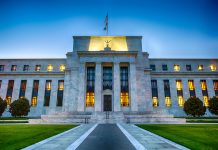Markets
The November yield correction found an easy way in at the start of the final month of the year through a disappointing US manufacturing ISM. The headline figure stabilized at 46.7 instead of improving to an expected 47.8. New orders fell though less rapidly (48.3 vs 45.5) while employment dropped to 45.8. Actual output fell sub 50 again after expanding for some months. Prices paid ticked higher to 49.9 though, potentially signaling that the strongest disinflationary pressures in the sector are easing. In Powell’s anticipated speech a bit later the Fed chair warned against speculating for rate cuts. But an otherwise balanced tone was not nearly enough to shift market thinking, especially after Waller’s comments earlier last week. Fed’s Goolsbee (“no evidence we stalled at 3% inflation”) and ECB’s Villeroy (“disinflation is even faster than expected”) all talked in the same direction. US yields hit a new correction low with daily changes varying between -10.6 (30-y) and -14.5 (5-y) bps. The 2-y (-14.2 bps) yield lost support at 4.60% (38.2% retracement on the 2023 yield rally). German yields followed their US peers lower with losses of 5.3 to 13.4 bps with similar outperformance of the front end. EUR/USD erased much of the earlier accumulated losses, rebounding from a low of 1.0829 to 1.0884 in the close. Stocks rallied. The EuroStoxx50 (4418) closed above resistance around 4400 and surpassed the 2021 recovery high. The only remaining reference standing in the way for a return to the pre-GFC high of 4572.82 is the current YtD high of 4491.51. US indices rallied 0.55-0.82%. The S&P500 came close to a test of the 2023 high (4607.07). Risk-on supported the likes of GBP. EUR/GBP tumbled to 0.8564 after testing support at the 76.4% GBP recovery on the H2 decline (0.85576). The hefty yield drop pushed the yen higher. USD/JPY closed at the lowest level since early September (146.82) while EUR/JPY lost the 160 mark. Gold advanced to 2072.22. The shiny metal hit a record high this morning by abruptly surging towards 2135.39 in a move that looks like stop-loss in a thin market. It pared gains to 2079.09, above the pandemic high of 2075.47 nonetheless. Today’s economic calendar is razor thin. ECB’s Lagarde appears at a conference today. She will touch on monetary policy in a last chance to do so before the blackout period kicks in later this week. We don’t expect her to turn the tide on markets. US yields recover a few bps this morning (5.5 bps at the front) but that’s merely stabilizing at the current levels. The dollar seeks to further capitalize on HICP-driven euro weakness by pushing the EUR/USD pair further south to 1.0868. Support at 1.0862 (50% retracement on the Oct-Nov rally) may soon break, introducing the next reference at 1.0764. The pound’s technical picture improved materially last week with the earlier mentioned resistance the only level standing in the way for a return to the YtD high (0.8492).
News & Views
After the S&P’s upgrade last month, rating agency Fitch on Friday also raised the credit long term foreign credit rating of Greece from BB+ to BBB- with a stable outlook. The agency sees the government debt to GDP ratio to ‘remain on a sharp downward trend, thanks to solid nominal growth, budget over-execution and a favourable debt servicing structure’. Fitch expects the country’s debt ratio to decline to 152.3% of GDP in 2024. The process is supported by ongoing solid growth expected at 2.9% next year after 2.4% this year. To support the fiscal consolidation process, the government also committed to further increase the primary budget surplus (balance excluding interest rate payments) from 1.1% this year to 2.1% next year.
The Hungarian debt agency AKK on Friday published its 2024 financing plan. The total net funding requirement for 2024 is HUF 2.515 billion, to be financed by a net issuance of HUF 2.643 billion. Contribution to the net issuance is expected to be HUF 1.528 billion in HUF retail securities and HUF 987 billion in FX financing. AKK plans a net negative institutional HUF bond issuance for 2024 with an average term-to-maturity of almost 7 years. On foreign currency financing, the 30% upper bound regarding the share of FX debt remains unchanged for 2024. AKK plans the issuance of an international USD bond with a volume of up to USD 2 billion and a benchmark sized green EUR bond in case of favourable market conditions in H1 2024. AKK also plans Samurai and Panda bond issuances in the second half of 2024 to further strengthen presence in Asian markets. FX project loans (e.g.: EIB, CEB, etc.) and other types of FX financing (e.g.: private placements, ECP) based on circumstances are also possible in 2024.














